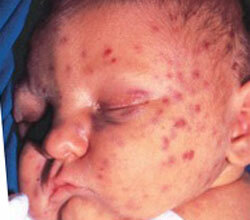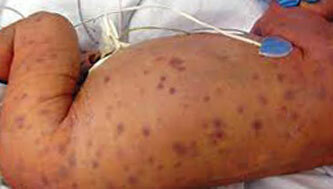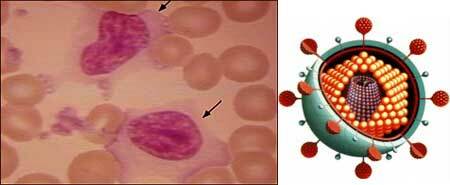In fact, cytomegalovirus infection is a chronic infectious disease that develops in a person after infection with the virus of the same name.
The causative agent belongs to the family of herpes viruses, the distinguishing feature of which is "eternal residence" in the body of the infected patient.
This fact makes the disease chronic, although in the main percent of infected people the infection in general can not be manifested in any way externally. In other cases, a wide range of manifestations is possible, including cytomegalovirus.
Very dangerous infection with cytomegalovirus infection for pregnant women - the consequences for the fetus can be the most tragic.
At birth, manifestations of this infection are recorded in 0.5 - 2.5% of infants. Often they can lead to severe pneumonia in newborns, requiring treatment in intensive care units for the youngest.
The relevance of this issue is particularly high, becauseThe prevalence of cytomegalovirus infection in adult women can reach 50-70%.However, it is especially dangerous to have a primary infection during pregnancy, when before that the patient did not come across this virus.
This is due to the lack of protective antibodies in her blood that limit the virus. Therefore, it easily penetrates directly to the fetus through the placenta. However, everything is in order. ..
Contents
- 1 Causes of the disease
- 2 Symptoms of cytomegalovirus infection in children and adults
- 3 Diagnosis CMVD
- 4 Treatment of cytomegalovirus infection
- 5 Cytomegalovirus infection in pregnancy
- 6 Prevention of the disease
- 7 Cytomegalovirus infection code μb 10
Causes of the disease

The cause of the disease is hitinfectious agent into the body with its subsequent reproduction, which leads to damagecells of many organs.
People with immune system disorders( HIV, various immunodeficiencies) or those due to their immaturity( fetus, newborns, children of older age) are at the most risk of becoming ill.
What is CMVI?This is a classical anthroponous infection, i.e."Supplier" of the pathogen will always be a person, i.e.it is not possible to get infected from animals or otherwise.
It should be taken into account that the most dangerous persons are those who do not have bright clinical manifestations.
Therefore, the surrounding people do not even guess that they are in contact with a potential source of the disease, the prevalence of which is very high.
So, in Russia, cytomegalovirus infection of adults is detected in 73-98% of the population, in children these figures are lower.
However, the development of the disease is possible in the presence of those factors:
- Meeting with the virus;
- Implementation of infection pathways in a specific infectious dose, i.e.the virus can penetrate only through a specific entrance gate and not every amount of it will be dangerous;
- Reduced immunity - the body is not able to eliminate the penetrated viral particles and cause their inactivation( death).
Transmission of cytomegalovirus is possible in the following ways:
- during pregnancy through the placenta( vertical);
- during labor( the virus is in the mucosa of the birth canal);
- by inhalation of infected saliva with kisses, close contacts;
- with sexual intimacy( condom is a remedy);
- is parenteral, i.e.through infected blood( blood transfusions, intravenous injections, organ transplantation).Therefore, donors of blood and organs must be examined for the carriage of cytomegalovirus.
In the external environment, the virus can survive for a long time at normal, room temperature. Its infectious ability, it loses on freezing only in -20 ° C, heating up to 56 ° C.
Therefore, for this infection, seasonality is not typical - cases of the disease are recorded throughout the year.
Symptoms of cytomegalovirus infection in children and adults

Symptoms of cytomegalovirus infection, photo 1
Symptoms of cytomegalovirus infection can be divided into manifestations of primary pathology( when the virus first enters the blood) and cytomegalovirus disease, the signs of which indicate the progress of the disease( the virus multiplies uncontrollably in the body andleads to numerous lesions of the internal organs).
Signs of a primary infection are similar to manifestations of infectious mononucleosis.
Therefore, the doctor necessarily conducts differential diagnosis with this disease using additional survey methods. Of the clinical manifestations indicating cytomegalovirus infection, it should be noted such as:
- high body temperature - it lasts for a long time( more than two weeks), accompanied by headache, muscle and joint pain;
- general malaise, increased fatigue, which is not associated with severe physical and mental stress;
- enlarged lymph nodes, their insignificant soreness;
- enlargement of the liver and spleen, in severe cases, the development of hepatitis and hypersplenism( increased activity of the spleen with the destruction of blood cells, leading to anemia and immunodeficiency).
Unlike adults, cytomegalovirus infection in children is accompanied by sialodenitis - a specific change in the salivary glands.
Symptoms of such lesions are:
- increased salivation, which can lead to maceration of the skin of the mouth and the formation of ulcers;
- pain during meals, against which the child often refuses;
- is a visually defined increase in glands in the submandibular region.
In the development of acute CMV after a blood transfusion( after 2-8 weeks) or organ transplantation( after 8-12 weeks), there may be:
- sudden rise in body temperature to 39-40 ° C;
- sore throat;
- weakness;
- enlarged lymph nodes;
- muscle pain;
- development of pneumonia, pleurisy, inflammation of the joints, hepatitis, nephritis.

CMV photo 2
Without treatment, primary infection after transplantation in 70-80% leads to death. Therefore, patients after organ transplantation are carefully monitored with a comprehensive examination.
It helps to identify possible infections and to carry out treatment in time. This is especially true, becauseIn the overwhelming majority of cases, the primary cytomegalovirus infection symptoms rarely.
Progressing, cytomegalovirus infection in adult women and men, is characterized in the literature as a disease of the same name. It begins with CMV syndrome.
Its symptoms are as follows:
- a long "incomprehensible" elevated body temperature( 38 ° C or more degrees);
- weakness;
- night sweats;
weight loss, not associated with a targeted restriction in food.
These signs develop gradually, within a few weeks. In 1-3 months, pathological changes begin in different organs.
Therefore, various diseases and pathological processes can be diagnosed:
- pneumonia;
- hepatitis;
- gastrointestinal ulceration;
- adrenal gland failure;
- radiculitis;
- headaches;
- retinal damage to the eye until loss of vision;
- inflammation of the heart muscle;
- impaired blood coagulation ability.
Diagnosis CMVD
 Identification of specific symptoms of cytomegalovirus infection, the treatment of which will be carried out purposefully, is impossible without laboratory and instrumental diagnostics.
Identification of specific symptoms of cytomegalovirus infection, the treatment of which will be carried out purposefully, is impossible without laboratory and instrumental diagnostics.
The choice of these or other methods will be determined by the doctor after a detailed interview of the patient. During it, the expert can identify important facts, namely:
- presence of contacts with patients with CMV;
- of unprotected sex;
- episodes of blood transfusions, organ transplants within six months.
These circumstances all require the exclusion or confirmation of CMV.
Therefore, the patient is organized:
- Special laboratory diagnostics. It consists in conducting a PCR test( the presence of viral DNA), serological testing( the presence of antibodies to the virus in the blood).
- Instrumental diagnostics. It allows you to detect signs of CMV disease. To do this, use chest X-ray, ultrasound, MRI, ECG, electroneuromyography. It is important to conduct timely ultrasound diagnosis in pregnant women, to identify violations in the development of the fetus.
Treatment of cytomegalovirus infection
The phases of the course of the disease, the symptoms of cytomegalovirus infection in women and men are similar, and the treatment is based on 3 important points:
- end of the life of the virus inside the body;
- preventing the development of CMV disease;
- prevention of complications and disabilities.
Patients with severe clinical manifestations should be treated in a hospital.
When pregnant in women, treatment depends on how great the possibility of infection of the fetus. A very careful attitude and control of the health of both the mother and the child is required.
The main drugs used in the treatment of CMV are Valganciclovir and Ganciclovir.
These are their international names( on the package they are written in small letters), brand names can be different depending on the manufacturer. With an active form of infection with the presence of severe symptoms, one drug is prescribed for a period of 21 days or more.
This duration of therapy is necessary to completely cut off the cycle of reproduction of the virus.
Criteria for successful treatment are the disappearance of clinical symptoms and the appearance of a negative result of PCR analysis on the DNA of the virus.
Therapy can be prolonged with a prophylactic goal. For this, a smaller dose of medication with an average duration of one month is used. If the symptoms of cytomegalovirus infection reappear, treatment should be repeated in full.
In a situation where the blood test results in the presence of the virus DNA, but there are no symptoms of the disease, a lower dose of the drug is prescribed for 1 month, after which the blood test for the presence of a viral nucleic acid( DNA) is performed.
Cytomegalovirus infection in pregnancy
 The most adverse effects of cytomegalovirus infection in pregnant women have fetal infection in the early stages.
The most adverse effects of cytomegalovirus infection in pregnant women have fetal infection in the early stages.
If the mother did not have a virus in the body prior to conception, but the infection occurred within 20 weeks of gestation - this is regarded as a primary infection. It is the most dangerous, becausein this case the probability of transmission of the virus to the fetus is high( 40%).
If the virus in a woman before the pregnancy or she has been infected again, the risk of infection of the fetus through the placenta is much lower - 0.2-2, 2%.
Early fetal infection results in:
- the possibility of spontaneous early termination of pregnancy;
- fetal death;
- delay / stop its development;
- stillbirth;
- formation of defects.
Infection of the fetus in later periods and during childbirth will consist in the child receiving the virus. Further development of the disease depends on the work of the immune system. If it is full, then the virus will be destroyed and the disease will not develop.
In pregnant women, the treatment of cytomegalovirus infection consists in the use of a specific anti-cytomegalovirus immunoglobulin, which is administered intravenously.
The drug is also prescribed for the prevention of fetal infection if the mother has this virus( only results of PCR analysis are taken into account, serological testing is less informative), and there are no symptoms of acute CMVI.

Danger of CMVI in pregnancy, photo 4
The use of similar drugs during pregnancy is possible. However, it has no proven effectiveness due to the insufficient number of studies conducted on this issue.
Perhaps, very soon there will be new, proven publications on CMVI therapy in pregnant women.
Prevention of
The preventive vaccine against cytomegalovirus infection does not exist. Prevention of infection is possible with the observance of general hygiene principles:
- sex only with the use of condoms;
- avoidance of close communication with the infected person( no kisses in the active period, only their utensils and hygienic means, etc.);
- frequent hand washing after using items that may contain saliva or urine sick( toys, diapers).
Since cytomegalovirus infection in women is dangerous for the possibility of transmitting the virus to the fetus during pregnancy, it is necessary to examine the blood for the presence of viral DNA and the corresponding antibodies. These studies are best done at the stage of pregnancy planning.
The cytomegalovirus test is part of the so-called TORCH study, which is mandatory in pregnant women before the 20th week. The question of the need for treatment should be decided individually, depending on how the previous pregnancies ended.
Cytomegalovirus infection code μB 10
Cytomegalovirus( B25)
- B25.0 Cytomegalovirus pneumonitis( J17.1 *)
- B25.1 Cytomegalovirus hepatitis( K77.0 *)
- B25.2 Cytomegalovirus pancreatitis( K87.1 *)
- B25.8 Other cytomegaloviral diseases
- B25.9 Cytomegalovirus disease, unspecified
Additionally:
B27.1 Cytomegalovirus mononucleosis
P35.1Congenital cytomegalovirus infection



